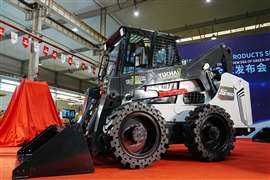Heavy lift cranes and their applications are increasingly spectatcular
11 January 2011

Lifts are certain to get heavier and more spectacular as the requirement for bigger modules and the machines to lift them continues. Euan Youdale reports.
Manufacturers and specialist lifting companies are introducing new super heavy lift machines with increased regularity, and new concepts are never far behind.
At Terex Cranes' recent Customer Days event in Germany, India-based Sanghvi Movers chairman Chandrakant Sanhgvi asked Doug Friesen, the manufacturer's vice president, if there were any plans to produce a crawler crane up to 5,000 tonnes capacity. The answer was emphatically to the negative. However, Sanghvi is not the first head of a major crane company to pose such a question, which demonstrates the potential need for a lifting device of this capacity. Perhaps, the next question would be something along the lines of, "how practical is it to produce a crawler crane of this size."
There are continual developments among all the manufacturers concerning heavy lift machines. Liebherr has patented a double crane lift concept in which two large crawlers could be attached at the boom tip and carbody for extra capacity. Although Wolfgang Beringer, spokesperson at Liebherr-Werk Ehingen, says the system has not developed further, he confirmed that the double boom concept is a "good idea."
ALE is building a second of its 4,300 tonne capacity AL.SK190 land-based cranes, with its double, joined boom attached to a fixed base. The crane comes with a 600 tonne quick winch system and boasts a 190,000 tonne-metre rating. Ballast to mast foot radius is 22.8 or 32.1 metres. The main mast can be configured to 61.2, 72.7, 84.2, 95.6, 107.0, 118.5, 129.9 or 141.3 m.
"The outstanding feature of the AL.SK190 is its large capacity and its ability to lift at a wide outreach, meaning that the crane doesn't have to be de-/re-rigged or relocated the way a crawler crane would. It can be transported in standard ISO containers and relocated on site fully assembled and rigged by skidding or SPMTs. It uses locally available ballast material," says Michael Birch, executive director, ALE projects.
The lifting capability, however, is only one consideration, adds Birch, "Oil, gas and petrochemical sites are becoming more challenging due to the lack of physical space available. As a result, the ability to lift off-plot is a massive advantage, which is why ALE has been investing so much in the AL.SK fleet."
Mammoet is also busy with its PTC 120/160 DS ring-based cranes, which Jan van Seumeren, Mammoet chief technical officer, describes as compact, quick and versatile. "The new cranes can also be used for smaller lifts. Their large radius means that many loads can be handled without having to move the crane, this versatility means you can keep the cranes busy all the time which facilitates a new approach to planning construction projects - saving you time and money," says van Seumeren.
There have also been a number of significant developments in wheeled mobile and crawler-based cranes. Liebherr is testing its 3,000 tonne capacity LR 13000 at its Ehingen factory in Germany. A new picture of the crane, now with boom attached and undergoing an overload test, is included in this feature. The manufacturer claims it will be the strongest conventional crawler crane in the world.
As far as telescopic booms are concerned, Liebherr's 1,200 tonne capacity wheeled LTM 11200-9.1 and crawler mounted LTR 11200, of the same lifting capacity, are notable recent additions. Soon the manufacturer will launch a 750 tonne capacity telescopic boom mobile crane on a 9 axle chassis, the LTM 1750-9.1. "The LTM 1750-9.1 will be the bigger brother of the successful [500 tonne] LTM 1500-8.1. The new crane is designed for fast and simple erection and easy use."
Terex's largest heavy lifter is the 3,200 tonne CC 8800-1 TWIN crawler crane. With its twin boom it has seen strong success since its launch in October 2007. It is a 1,600 tonne capacity CC 8800-1 with a kit of parts to double the boom and the lifting capacity.
A fifth model of the Twin is now in production and there is interest in the crane from potential customers in Russia, North America and China, according to the company. "The Twin represents a considerable saving of both time and space requirements in the erection of large industrial facilities, when compared with ring lift cranes and jacking towers," says Guntram Jakobs, product marketing manager.
In recent years Terex has reflected the increasing desire for cranes in the 1,000 to 2,000 tonne range with its 1,600 tonne CC 9800 crawler and 1,000 tonne capacity AC 1000 wheeled mobile, shown at April's Bauma 2010 exhibition in Germany.
In China, domestic manufacturers have rapidly developed heavy lifting product. In the last couple of years large crawler cranes launched include a 2,000 tonner from XCMG, 1,600 and 1,000 tonners from Sany, and a 750 tonner from Fuwa. The two largest are rated at 28,000 and 25,000 tonne-metres, respectively.
Wheeled mobiles launched at November's bauma China exhibition in Shanghai include 1,000 tonne class models with telescopic booms from Sany and XCMG, plus 800, 500 and other high capacity all terrains from them and Zoomlion.
In development at Sany is a 3,000 tonne class lattice boom crawler and the company has shown a concept drawing of a double boom 60,000 tonne-metre giant heavy lifter on four crawler tracks.
Alternatives
Alternative forms of lifting are also becoming increasingly common in the world of increasing module size and weights.
ALE has also designed and built an hydraulic skid system for the lifting and horizontal movement of offshore modules. It incorporates ALE's new 650 tonne skid shoes. Secured by a strong box construction in the top of the housing to provide strength and stability, the skid shoes are hydraulically driven by 83 tonne capacity push-pull units to slide over Teflon (PTFE) blocks in the skid track, with the load on the skid shoes supported by hydraulic cylinders. The cylinders from each of the skid shoes are hydraulically connected to create either a 3 or 4 point suspension system that supports the load without overstressing, says the company.
French lifting services giant Mediaco has recently invested in high capacity gantry equipment, along with lattice boom crawlers up to 820 tonnes, says Christian Jacques Vernazza, Mediaco-Lifting president. "We will follow the market and the new equipment proposed by our suppliers, according to the kind of work we will have to do in the future."
Mediaco's work in the heavy lift domain is wide ranging and demonstrates its importance in today's market, which is considerably slower across lower capacity sectors. At the time of writing in November the company was active lifting load beams weighing 1,500 tonnes building a sports stadium. The company was using four 400 tonne capacity lattice boom crawlers, as well as an additional 600 tonne capacity crawler. "We are working to build or dismantle nuclear plants - this market is increasing in France and our group specialises in such technical operations." Opportunities are also arising in chemical and petrochemical industries as well as the UEFA 2016 European Football championship.
Many of the larger rental companies are optimising their capabilities to offer a complete service through planning, transportation and lifting - another reason why companies are investing in alternative lifting equipment. Prangl is another example.
"We have also invested in gantry cranes, heavy lifting portals, strand jacks and skidding systems. We are now able to offer our customers complete solutions in the fields of heavy lifting and moving," says Christian Prangl, managing director.
All the equipment can be broken down to fit standard containers, for example. "Therefore logistic costs can be kept to a minimum," says Prangl, "Thus we can offer maximum flexibility for almost every inquiry. Our strand jacks and hydraulic gantry cranes can lift up to 1,100 tonnes. Moving loads up to 500 tonnes can be easily done with our special skidding systems and all machines can be combined with each other."
As pre-assembled modules get bigger and more common, these attributes will become increasingly important. "To be able to handle these weights and dimensions, you need to offer a wide variety of different heavy lifting and moving equipment - especially when space is confined in already existing power plants," adds Prangl.
Japan-based Kobelco is another manufacturer to have identified these needs. It launched the 550 tonne capacity SL6000 and the 400 tonne SL4500 crawlers in 2006 and 2008, respectively. "These two models are targeting power plant, chemical plants and/or the wind energy industry. However, the world of heavy lift is changing rapidly and now the 550 tonne class crawler crane is being used as a sub-crane to over 1,000 tonne class crawler cranes, such as tailing lifts in module block installation. Therefore we, Kobelco, need to go to the correct size when it comes to the next new launch for the heavy lift world," says Bruce Yanagido, product planning department manager.
Neil Partridge, managing director of leading UK crane company Ainscough says the demand is for increased lifting capacities while maintaining flexibility for power generation, renewables, nuclear and infrastructure. "Yes we are seeing modularisation being cost effective for our clients requiring larger capacity cranes and for sure there is going to be a huge demand for the nuclear build programme."
These requirements are clear but the future of regulation harmonisation across countries and states, particularly concerning road regulations is less clear. Christian-Jacques Vernazza, president of the European Association of Heavy Haulage, Transport and Mobile Cranes (ESTA), explains that the association is continuing its work in this area. "ESTA association is also working on a harmonisation in Europe of working conditions, best practices and cheaper cranes, so to be affordable and cost-effective. Nowadays the manufacturers must keep in touch with users to meet their needs and recommendations in order to provide the best evolution in the equipment they supply."
There are continued efforts, through discussions with national European governments, to make the process of transporting cranes easier and faster. Vernazza adds, "We should have a special category for the special transport for cranes, as cranes contrary to haulage, transport always the same weight of the superstructure and should have yearly authorisation on the main road and highway. The manufacturers must be more involved and present to help users on that subject."






